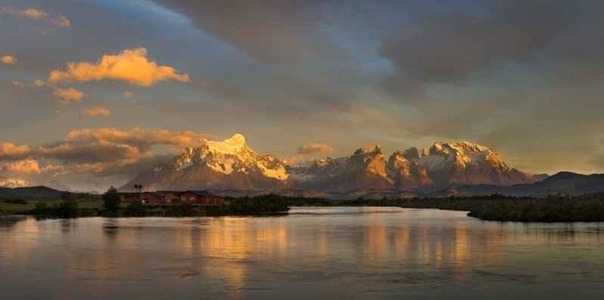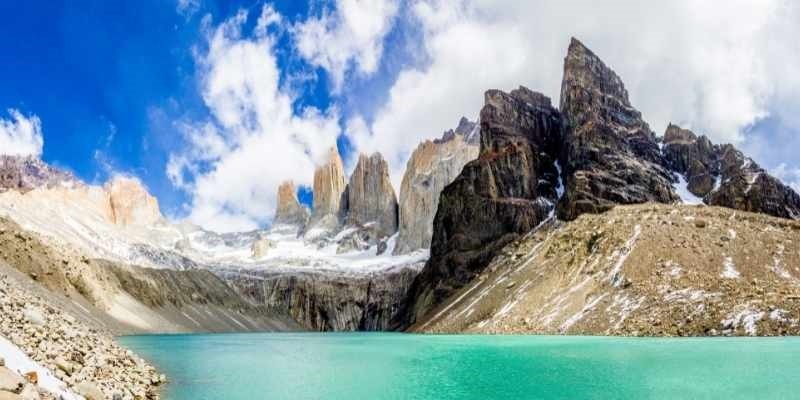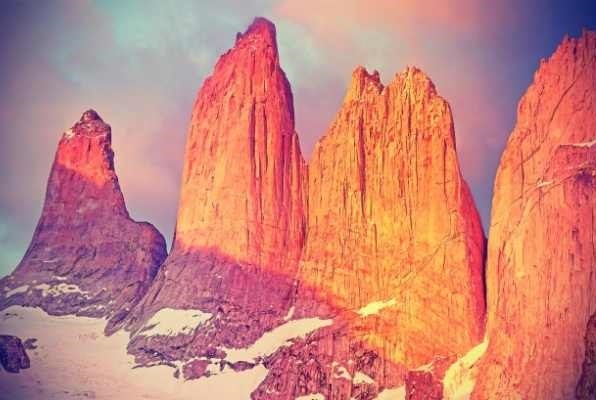The Torres del Paine National Park is undoubtedly one of the most famous destinations in Patagonia. The national park includes much more than just the world-famous pinnacles – it is a paradise for animals and plants and an idyll for photographers, hikers and mountaineers.
Torres del Paine
The cinematic backdrop of the eighth wonder of the world will leave you open-mouthed.
It’s worth packing your backpack and hiking boots and taking the adventure of Torres del Paine National Park.
If you travel in the South American summer, you can enjoy 17 hours of daylight in the park. Don’t miss the sunrise when the three gigantic pinnacles in the national park turn a soft purple and bright red.
There’s plenty to experience in the park on a four-day hike of the famous W Circuit Trail. There is the opportunity to sail across Lake Grey and admire the gigantic glacier of the same name.
The Flora and fauna of the Torres del Paine National Park are of extraordinary diversity. Giant Condors circle over the national park. You will see foxes and the South Andean deer along the way. You may also be lucky enough to spot a Puma.
The favourite of the park visitors are the Guanacos, the wild form of the llamas. The curious four-legged creatures form a popular photo motif in front of the fantastic backdrop of the park landscape and sometimes seek the proximity of the hikers.
The small Andean camels are peace-loving. Only if they feel harassed, they defend themselves by spitting. Other mammals, such as the pronghorn deer, are shyer and rarely seen. You will certainly encounter Darwin’s rhea.
Besides glaciated areas, the landscape is characterized by many lakes, high mountains as well as tundra and huge forests. Lenga trees, Olivillo trees and Cypresses grow here, and lots of flowers, first of all, countless orchids, make the hiker’s heart beat faster.
It is not promised too much when we say that this magical place will enchant you.
A Paradise for Hikers
The Torres del Paine National Park is Patagonia’s flagship and an El Dorado for trekking fans. In the park, hikers see everything that makes up Patagonia.
You can marvel at imposing glaciers with large lakes, filigree rock needles and steep walls, with the vastness of the steppe in between. The perfect tour for Patagonia beginners is the Torres del Paine W-Trek. The trail leads to all the highlights of the park in four days.
The “W” gives its name to the shape of the trek: The left outer part runs between the Grey Glacier and its glacial lake and the Cerro Paine Grande massif – the middle part leads through the Valle del Francés to the imposing walls of Cerro Castillo.
The outermost segment runs in and out of the valley of Torres del Paine, the three imposing granite towers. They are the landmark and namesakes of the park.
Towers of Paine
The three granite needles of the Torres del Paine National Park – “Towers of Paine” are the landmark of the national park of the same name.
They rise majestically into the sky in front of you. They were formed more than ten million years ago when liquid magma from the belly of the earth surged upward and cooled there to form black shale.
After being eroded by ice-age glaciers, these rocks now appear in the fascinating form. The former magma can be found in the light granite while the shale covers the peaks as a dark cap.
Interesting facts about the Torres del Paine
The famous Torres del Paine Park was founded already in 1959; the administration of the national park was taken over by the forestry authority CONAF from Chile.
UNESCO then declared Torres del Paine National Park a Biosphere Reserve in 1978. About the region around Torres del Paine National Park, it must be said that the last ice age in Patagonia ended about 14,000 years ago, and the glaciers have been retreating ever since.
But until today, quite large parts of the national park are glaciated, and so the ice of the glaciers here belongs to the view in the Torres del Paine National Park.
One glacier in the national park is even more famous than others and is also a popular photo motif – the Grey glacier, which runs out into the lake of the same name and is a truly imposing sight.
Despite the strong glaciation, Torres del Paine National Park is very rich in vegetation, which of course, adds to the charm of the region and makes the landscapes in the park so worth seeing.
Climate and Best Travel Time
Torres del Paine National Park is located in southern Chile, in Patagonia, and has a cool and quite humid climate in winter. The seasons in Torres del Paine National Park are opposite to the seasons in the U.S. In the summer, the national park has an average temperature of 11 degrees.
In winter, between May and August, the average temperature is 1 degree, but much lower temperatures are possible and should be considered when choosing the right clothing.
In summer, the sun often shines in Torres del Paine National Park, and long days are the norm in this region.
The best time to travel to Torres del Paine National Park is, therefore, between September and March. However, with the right clothing, the national park is a recommended destination all year round.
Addresses and Travel Information
- Arrival: By plane via Santiago de Chile to Punta Arenas and by bus 5 hours to Torres del Paine National Park. Alternatively, via Buenos Aires to El Calafate and by bus to Torres del Paine.
- Accommodations: There are sophisticated hotels, refuges and campsites in the national park. Eco-Camp offers the comfort of a hotel and the youthful charm of a tent village.
- Dining: The restaurants focus on international dishes. However, local specialties such as grilled beef and lamb, delicacies from the sea and red wine made in Chile are also offered.
- Map: At the entrance to the national park, each visitor receives a map.
More information: https://torresdelpaine.com/




